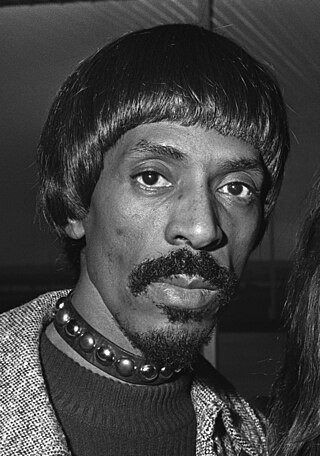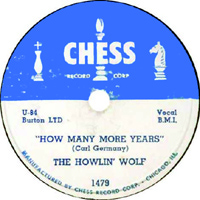
Blues is a music genre and musical form that originated amongst African-Americans in the Deep South of the United States around the 1860s. Blues incorporated spirituals, work songs, field hollers, shouts, chants, and rhymed simple narrative ballads from the African-American culture. The blues form is ubiquitous in jazz, rhythm and blues, and rock and roll, and is characterized by the call-and-response pattern, the blues scale, and specific chord progressions, of which the twelve-bar blues is the most common. Blue notes, usually thirds, fifths or sevenths flattened in pitch, are also an essential part of the sound. Blues shuffles or walking bass reinforce the trance-like rhythm and form a repetitive effect known as the groove.

Izear Luster "Ike" Turner Jr. was an American musician, bandleader, songwriter, record producer, and talent scout. An early pioneer of 1950s rock and roll, he is best known for his work in the 1960s and 1970s with his wife Tina Turner as the leader of the Ike & Tina Turner Revue.

Chester Arthur Burnett, better known by his stage name Howlin' Wolf, was an American blues singer and guitarist. He was at the forefront of transforming acoustic Delta blues into electric Chicago blues, and over a four-decade career, recorded blues, rhythm and blues, rock and roll, and psychedelic rock. He is regarded as one of the most influential blues musicians of all time.
Electric blues is blues music distinguished by the use of electric amplification for musical instruments. The guitar was the first instrument to be popularly amplified and used by early pioneers T-Bone Walker in the late 1930s and John Lee Hooker and Muddy Waters in the 1940s. Their styles developed into West Coast blues, Detroit blues, and post-World War II Chicago blues, which differed from earlier, predominantly acoustic-style blues. By the early 1950s, Little Walter was a featured soloist on blues harmonica using a small hand-held microphone fed into a guitar amplifier. Although it took a little longer, the electric bass guitar gradually replaced the stand-up bass by the early 1960s. Electric organs and especially keyboards later became widely used in electric blues.

Gustavus Cannon was an American blues musician who helped to popularize jug bands in the 1920s and 1930s. There is uncertainty about his birth year; his tombstone gives the date as 1874.
The story of Tennessee's contribution to American music is essentially the story of three cities: Nashville, Memphis, and Bristol. While Nashville is most famous for its status as the long-time capital of country music, Bristol is recognized as the "Birthplace of Country Music". Memphis musicians have had an enormous influence on blues, early rock and roll, R&B, and soul music, as well as an increasing presence in rap.
Mississippi is best known as the home of the blues which developed among the freed African Americans in the latter half of the 19th century and beginning 20th century. The Delta blues is the style most closely associated with the state, and includes performers like Charley Patton, Robert Johnson, David "Honeyboy" Edwards, Willie Brown, Tommy Johnson, Ishmon Bracey, Bo Carter, Sam Chatmon, Mississippi John Hurt, Furry Lewis, Son House, Skip James, Muddy Waters, Howlin' Wolf, John Lee Hooker, Pinetop Perkins, and B.B. King.
Blues rock is a fusion genre and form of rock music that relies on the chords/scales and instrumental improvisation of blues. It is mostly an electric ensemble-style music with instrumentation similar to electric blues and rock. From its beginnings in the early to mid-1960s, blues rock has gone through several stylistic shifts and along the way it inspired and influenced hard rock, Southern rock, and early heavy metal.
The origins of rock and roll are complex. Rock and roll emerged as a defined musical style in the United States in the early to mid-1950s. It derived most directly from the rhythm and blues music of the 1940s, which itself developed from earlier blues, the beat-heavy jump blues, boogie woogie, up-tempo jazz, and swing music. It was also influenced by gospel, country and western, and traditional folk music. Rock and roll in turn provided the main basis for the music that, since the mid-1960s, has been generally known simply as rock music.

Auburn "Pat" Hare was an American electric blues guitarist and singer. His heavily distorted, power chord–driven electric guitar performances in the early 1950s is considered an important precursor of heavy metal music. His guitar work with Little Junior's Blue Flames had a major influence on the rockabilly style, and his guitar playing on blues records by artists such as Muddy Waters was influential among 1960s British Invasion blues rock bands such as the Rolling Stones and the Yardbirds.

Willie Johnson was an American electric blues guitarist. He is best known as the principal guitarist in Howlin' Wolf's band from 1948 to 1953. His raucous, distorted guitar playing is prominent on Howlin' Wolf's Memphis recordings during 1951–1953, including the hit song "How Many More Years".
The Memphis Jug Band was an American musical group active from the mid-1920s to the late-1950s. The band featured harmonica, kazoo, fiddle and mandolin or banjolin, backed by guitar, piano, washboard, washtub bass and jug. They played slow blues, pop songs, humorous songs and upbeat dance numbers with jazz and string band flavors. The band made the first commercial recordings in Memphis, Tennessee, and recorded more sides than any other prewar jug band.

Moanin' in the Moonlight is a compilation album and the first album by American blues artist Howlin' Wolf, released by Chess Records in 1959. It contains songs previously issued as singles, including one of his best-known, "Smokestack Lightning". Rolling Stone ranked it number 477 on its 2020 list of "the 500 Greatest Albums of All Time".

Willie Nix was an American Chicago blues singer and drummer, active in Memphis, Tennessee, in the 1940s and 1950s.

Lester Hill, known professionally as Joe Hill Louis, was an American singer, guitarist, harmonica player and one-man band. He was one of a small number of one-man blues bands to have recorded commercially in the 1950s. He was also a session musician for Sun Records.

Raymond Earl Hill was an American tenor saxophonist and singer, best known as a member of Ike Turner's Kings of Rhythm in the 1950s. He also recorded as a solo artist for Sun Records and worked as a session musician.

"How Many More Years" is a blues song written and originally recorded by Howlin' Wolf in 1951. Recorded at the Memphis Recording Service – which later became the Sun Studio – it was released by Chess Records and reached No. 4 on the Billboard R&B chart. Musician and record producer T Bone Burnett has described "How Many More Years" as "in some ways ... the first rock’n’roll song". It was a double-sided hit with "Moanin' at Midnight", which reached No. 10 on the R&B chart.

"Moanin' at Midnight" is a blues song written and recorded by Howlin' Wolf in 1951. The recording was released on Chess Records as his debut single. It charted on Billboard's R&B chart, but the B-side, "How Many More Years," became the popular side of the record.
Willie Kizart was an American electric blues guitarist best known for being a member of Ike Turner's Kings of Rhythm in the 1950s. Kizart played guitar on "Rocket 88" in 1951, which is considered by some accounts to be the first rock and roll record. The record is noted for featuring one of the first examples of distortion ever recorded; played by Kizart.
The Beale Streeters were a Memphis-based R&B coalition of musicians, which at times included John Alexander, Bobby Bland, Junior Parker, B.B. King, Earl Forest, Willie Nix, and Rosco Gordon. Initially, they were not a formal band, but they played at the same venues and backed each other during recording sessions.













